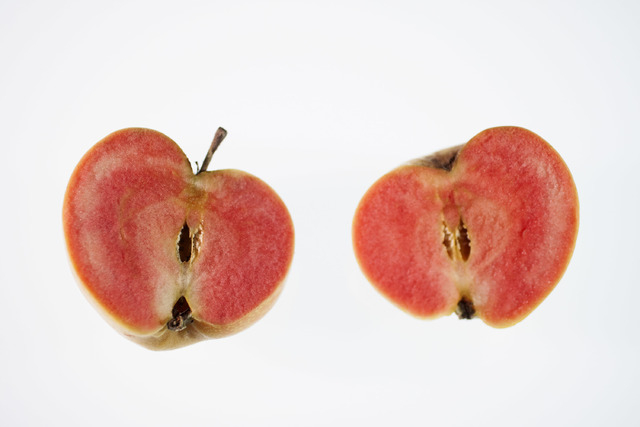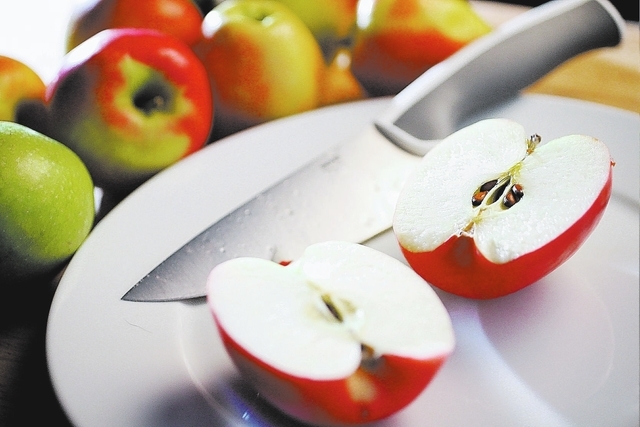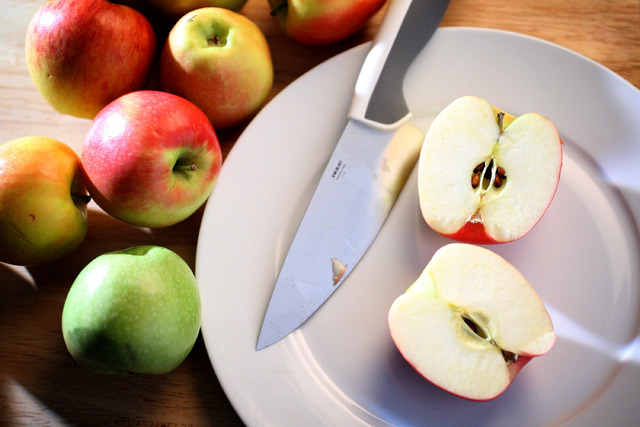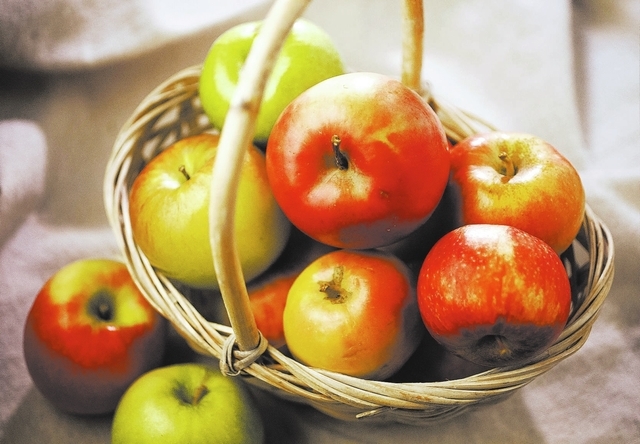How do you like them apples?





The difference between an apple and an orange? How about the difference between an apple and an apple? This seemingly straightforward, most American of fruits actually is possessed of complexities that can make one variety very different from another.
Sue Lednicky, a nutrition educator with University of Nevada Cooperative Extension, said what she likes about apples is pretty basic: “I like to eat them.” But when asked to elaborate, she gets a little more discriminating.
“My favorite is the Gala,” Lednicky said. “I like it because it’s so crisp and so tart but so sweet at the same time. My son, however, prefers either a Honeycrisp or a Pink Lady.
“I think that’s probably what I like best about apples — there are so many different kinds. So one apple’s not the same as another.”
And how. Kerry Clasby, an urban forager whose California Family Farms is at the Bet on the Farm market from 10 a.m. to 1 p.m. Thursdays at Springs Preserve and the Downtown3rd Farmers Market from 9 a.m. to 3 p.m. Fridays near U.S. Highway 95 and Casino Center Drive, said one of the more unusual apples she has brought to market recently is the Pink Pearl, whose yellow skin conceals a shocking-pink interior worthy of a ’60s decor scheme. A low producer, it grows in mountainous areas.
“It’s crunchy and sweet, high-acid, just a great apple,” she said. “It makes a tremendous applesauce. They’re gorgeous on a plate.”
We’re just getting into prime season for apples. Early season varieties are in stores now (Pink Pearl will be gone by mid- to late September, Clasby said), with others coming to market during the fall and winter. Some, like the ubiquitous Granny Smith, Red Delicious and Golden Delicious, are available year-round.
That might explain the vast popularity of those three old reliables. Granny Smiths are the principal apple crop at Gilcrease Orchard in the northern part of the valley, where orchard director Mark Ruben said they’ll be ready in early October.
“They’re a firm, good cooking apple,” Ruben said, although they’re good for snacking as well.
“If I’m making pies, I like to use a Rome apple, along with a tarter apple like a Granny Smith or something like that,” Lednicky said. “For sauces, it just depends on what I have on hand, actually.”
Ruben said he now has Jonagolds, which are a cross between the Jonathan and the Golden Delicious.
“It’s not sour or sweet; it’s just a nice eating apple,” he said. “We do have Pink Lady that will be available in October, but there are so few of them because the trees are so young that most people are going to pick them before they’re ready.”
Some apple varieties are nearly as familiar as the Granny Smith.
“From (Tom) Colicchio to (Mario) Batali — all the great chefs — one of the No. 1 apples that comes up is the Fuji,” Clasby said. “The Fuji apple is just such a great apple. The beginning of the season is starting now; it will go for months, it’s such a great producer.”
Others are far more obscure. The Japanese Mutzu, Clasby said, will start next week; it has a yellow skin and is low in acid, crunchy, sweet and fresh-tasting.
“It’s a great apple,” she said. “Great for applesauce, great for baking.”
Then there’s the Roxbury Russet, which Clasby said first was cultivated in England in the 1600s, later was popular in New England and sort of resembles a russet potato.
“They were cultivated for their flavor and their longevity, producing through the cold in New England,” she said. “That russet skin make them not so pretty. They’re a great crunchy fall heirloom apple.”
And she’s expecting something even more exotic: the Winter Banana Apple.
“It’s pale yellow, with a rose blush,” she said. “It’s very sweet and has a banana taste and smell. That’s why they call that a banana apple.”
¼ cup coarsely chopped walnuts
3 tablespoons dried currants
2½ tablespoons brown sugar
¾ teaspoon ground cinnamon (divided use)
4 medium Granny Smith apples, cored
1 cup packed brown sugar
¾ cup apple cider
Combine first three ingredients in a small bowl; add ¼ teaspoon cinnamon, stirring to combine. Peel top third of each apple; place apples in an electric slow cooker. Spoon walnut mixture into cavity of each apple.
Combine the remaining ½ teaspoon cinnamon, 1 cup brown sugar and apple cider in a small bowl, stirring to combine. Pour over apples. Cover with lid; cook on low 2¾ hours. Remove the apples with a slotted spoon. Spoon ¼ cup cooking liquid over each serving.
Serves 4.
— Recipe from Cooking Light
2 pounds McIntosh apples, peeled and cored (6 large apples)
2 pounds Granny Smith apples, peeled and cored (4 large apples)
1 cup apple cider
2 cups granulated sugar
2 tablespoons lemon juice
Cut McIntosh apples into 1-inch pieces. Cut Granny Smith apples into smaller dice.
Combine apples and cider in a very large stainless steel or enamel saucepan. Bring to a boil over medium-high heat, stirring occasionally. Reduce heat and boil gently for 20 minutes or until mixture is reduced by half.
Stir in sugar and lemon juice. Return to a boil, reduce heat and boil gently for about 25 minutes or until mixture is very thick. There should still be some tender apple chunks remaining. Remove from heat.
Ladle into sterilized jars and process.
Note: For spiced apple butter, add 2 teaspoons ground cinnamon and ½ teaspoon each ground cloves and allspice with the sugar.
Makes 7 cups.
— Recipe from Epicurious
1 box pound cake mix (do not use a moist cake mix)
2 teaspoons ground cinnamon (divided use)
1 cup chopped pecans, toasted
1 stick unsalted butter at room temperature
2 tablespoons cornstarch
½ teaspoon ground cloves
½ teaspoon salt
½ cup sugar
8 Gravenstein apples, cored, pared and sliced as for apple pie
Whipped cream or vanilla ice cream for serving
Preheat oven to 350 degrees.
Combine cake mix, 1 teaspoon cinnamon, pecans and butter and mix with either fingertips or a fork until blended and crumbly.
Combine cornstarch, remaining cinnamon, cloves, salt and sugar.
Toss cornstarch mixture with sliced apples until apples are well coated. Let stand for 5 minutes.
Butter a 9-by-13-inch glass baking dish. Place apple mixture in dish. Sprinkle cake mixture over apples (it will appear lumpy).
Bake for 45 minutes or until cake topping is golden brown and apples are bubbling and tender.
Serve warm with whipped cream or vanilla ice cream. Refrigerate leftovers.
Serves 9 to 12
— Recipe from Sonoma County Tourism
1 (3-pound) bag small apples (12 to 14 apples)
2 cups sugar
1 cup vegetable oil
3 large eggs, lightly beaten
2 teaspoons vanilla extract
3 cups all-purpose flour
2 teaspoons ground cinnamon
1 teaspoon baking soda
½ teaspoon salt
2½ cups chopped pecans, toasted and divided
Quick Caramel Frosting (recipe follows)
Peel, core and cut four apples into 24 (¼-inch-thick) rings. Saute apple rings, in batches, in a lightly greased skillet over medium heat 1 to 2 minutes on each side or until lightly browned. Remove from skillet and place one apple ring in the bottom of each of 24 lightly greased muffin pan cups.
Peel and finely chop enough remaining apples to equal 3 cups. Set aside.
Stir together sugar and next three ingredients in a large bowl.
Stir together flour and next three ingredients; add to sugar mixture, stirring just until blended. (Batter will be stiff.) Fold in finely chopped apples and 1 cup pecans.
Spoon batter evenly over apple rings in muffin pan cups, filling cups three-quarters full.
Bake at 350 degrees for 25 minutes, or until a wooden pick inserted in center comes out clean. Remove muffins from pan and cool, apple rings up, on a wire rack.
Press the handle of a wooden spoon gently into the center of each apple ring, forming a 1-inch-deep indentation in the muffins.
Spoon warm Quick Caramel Frosting evenly over muffins, filling indentations. Sprinkle evenly with remaining 1½ cups chopped pecans.
Makes 2 dozen.
Quick Caramel Frosting: Place 2 (14-ounce) cans sweetened condensed milk, ½ cup firmly packed light brown sugar, ½ cup butter and 1 teaspoon vanilla extract in a heavy 3-quart saucepan; bring to a boil, stirring constantly, over medium-low heat. Cook, stirring constantly, 3 to 5 minutes or until mixture reaches a puddinglike thickness. Remove from heat.
— Recipe from Southern Living
Contact reporter Heidi Knapp Rinella at hrinella@reviewjournal.com or 702-383-0474.
FILE UNDER FLAVORFUL
Braeburn: From New Zealand and of uncertain parentage, discovered as a chance seedling. May be descended from Lady Hamilton and Granny Smith. Rich, sweet-tart and spicy, good for snacking and baking.
Cripps Pink, also known as Pink Lady: Cross of Golden Delicious and Lady Williams. Developed in Australia. Tart and sweet, good for snacking and baking.
Fuji: Cross between Red Delicious and Ralls Janet, developed in Japan. Crisp and super-sweet, good for baking.
Gala: Cross between Kidd’s Orange and Golden Delicious, developed in New Zealand. Aromatic and sweet, used for snacks and salads.
Granny Smith: Tart and versatile, good for snacking, salads and baking. Developed in Australia; believed to be descended from French crabapples cultivated by — wait for it — Maria Ann Smith.
Gravenstein: Native to Denmark, where it was encountered as a chance seedling, it’s tart and used for juices and applesauce.
Honeycrisp: Developed by the University of Minnesota. Sweet and slightly tart, good for salads, cooking, baking and snacks.
Pink Pearl: Crunchy and sweet, high in acid, it’s good in salads and desserts.
SweeTango: Cross between Honeycrisp and Zestar.
Sources: Washington Apple Commission, Kerry Clasby.


















